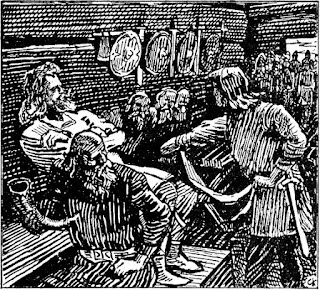Several years ago a friend of mine told me about a runestone found in Oklahoma. I laughed. No, he insisted, it really did exist. So like most skeptics I ignored it as another Piltdown man hoax. But I never forgot his insistence that Vikings may have traveled to Oklahoma, among other places. So when I stumbled across a listing of purported Viking runes and artifacts, I couldn’t help but think it would make an interesting post at some point. Well, my eager readers, today is the day.
Where We Know the Vikings Did Show Up
Few archaeologists will argue that Vikings didn’t land in North America, and set up colonies, but few would actually claim that they headed farther south than the runestones seem to suggest. We know that there was a Viking settlement at L’Anse aux Meadows, and recently there has been another discovery at Point Rosee, some 370 miles away from the first confirmed site.
How Tough Would It Have Been for Vikings to Travel Inland?
If Point Rosee is a Viking settlement site (jury is still out on it, but I suspect it probably is), how tough would it have been for the Vikings to head a bit more south? I’m hesitant to say that it’d be easy, because it certainly would not have been. But the Vikings were masters at travel, and if anyone could’ve navigated uncharted territory, it would have been them. But North America is sizable, and it would take extraordinary people to accomplish this, even among Vikings. Still, people with no more than their feet have traveled across North America in prehistoric times.
Let’s Get to the “Evidence,” Shall We?
I placed the word “evidence” in quotes because, quite honestly, it’s hard to establish these as real and not elaborate hoaxes. In many cases, science has dismissed certain “Norse artifacts” when data proves that they are anything but. So let’s look at three pieces of allegedly Viking artifacts.
The Newport Tower in Rhode Island
If I could point to one thing that is sketchy when it comes to Norse artifacts, it would be the Newport Tower in Rhode Island. Proponents claim that Norse built it somewhere between the 11th century and the 14th century. Most scholars consider it a windmill and not a tower built by the Norse (when did the Vikings ever have this type of architecture anyway?) This was originally proposed by Danish archaeologist Carl Christian Rafn in 1837.
Others have expanded on the theory, but carbon dating places its age at the mid-17th century. Still, there are those who purport that it is some antiquated tower and not a windmill (most experts believe it is a windmill), saying that it was built in the 15th century, underwent a fire, and then was rebuilt in the 17th century.
Despite the various arguments, I’m going to have to go with the establishment and call this one as a windmill and not a special tower. Certainly nothing that the Vikings would ever construct.
The Kensington Runestone
The Kensington Runestone is a more interesting find. There’s some debate about it, but the general consensus is that it’s a hoax. However, there are some interesting points to be made why it might be authentic.
The runestone was purportedly “found” by Olof Ohman, a Swedish immigrant who lived near Kensingon, Minnesota. He was digging up the roots of a poplar (or aspen, depending on what account you read) on his farm, and allegedly found it with the roots growing around it. It’s 3 feet long, 16 inches wide, and 6 inches deep.
Now, being the suspicious type, reading about a Swedish person uncovering runes seems a little odd to begin with. The red flags went up with that one. Anyway for those interested, the runes translate as follows:
- “Eight Geats and twenty-two Norwegians on an exploration journey from Vinland to the west. We had camp by two skerries one day’s journey north from this stone. We were [out] to fish one day. After we came home [we] found ten men red of blood and dead. AVM (Ave Virgo Maria) save [us] from evil.”
- “[We] have ten men by the sea to look after our ships, fourteen days’ travel from this island. [In the] year 1362.” — Source, Wikipedia.
Now, this sounds really cool, doesn’t it? There was a group of Norse explorers led by Paul Knutsson sent by King Magnus Eriksson of Sweden and Norway into the west. But there aren’t any records whether they truly embarked on their mission. If they did go, they never returned. So, it’s a possible link.
Swedish linguists pronounced the piece as a fake due to wording that did not exist in the Swedish lexicon until the 16th century. The runes, too, seem to be a mix of old and newer runes that would not have been used in the 14th century. That being said, other linguists have challenged that, saying that the usage could be a variation due to regional dialects. Still, many linguists do claim that this stone is most likely a hoax by Ohman and others who live in Kensington.
What do I think? I think it is most likely a fake, especially when other definite hoax runestones were found in the area. From my own experience, aspen trees only live about 15-20 years and those poplars near where the stone was found were no more than 40 years old. The Swedish written on the stone was closer to 19th century than 14th century, thus making it most likely a hoax. Still, if it’s real, it’s a cool piece. By the way, it has its own museum in Alexandria, Minnesota, so you can check it out.
The Heavener Runestone
The last piece of alleged “Viking artifacts” I’ll be talking about comes from Oklahoma, where, oddly, there are quite a number of found runestones, most considered to be fakes due to the lack of weathering on them. That being said, the Heavener Runestone is the most famous of the lot. Made famous by Gloria Farley in the 1950s, the rock had been called “Indian Rock” for more than 100 years because people believed that it had been carved by Native Americans. The runestone is 12 feet tall, 10 feet wide, and 16 inches thick. It is now a state park, and whether it is really a runestone from Viking explorers or not, it is at least preserved for all to see in a building that was built around it. Scholars have argued over the translation of either “Gnome dal” or “Glome dal,” meaning either “sundial” or “Glome’s Valley,” depending on which translation you choose. It is thought it may be a boundary marker and may be as old as the 7th century.

The problem with the Heavener Runestone is that it is just one piece of evidence that doesn’t seem to have any other archaeological evidence to back it up. We don’t know what the carver meant when he or she chiseled the runes into the rock and we don’t have any written account of there being Vikings in this land. Also, we don’t have any other finds that would suggest that the Vikings rowed their ships down the Arkansas River to carve this stone, other than the stones that experts consider to be carved sometime in the 19th or 20th centuries.
A Lewis and Clark Comparison (Stay with me on this)
All that being said, I’d like to compare this to a 19th expedition that did happen, that is the Lewis and Clark Expedition of 1804 to 1806. We know it happened because of all the written records. Plus, while there is no one alive who remembers that expedition, there were people who knew about, talked about it to others, and wrote about it. Despite all that we know about the expedition, the only archaeological evidence of the expedition was at a place called Traveler’s Rest in Lolo, Montana.
Suppose for a moment that nothing was written down about the expedition. That there was pretty much no documentation. Then the only evidence that Thomas Jefferson sent men out to explore the Louisiana Purchase would’ve been the archaeological evidence at Traveler’s Rest. Assuming the US boundaries of the time, would we assume that people traveling from the states somehow ended up in Montana without any other evidence? We might say “Possible but not probable.”
So What Does the Rational Heathen Think?
It’s an interesting intellectual exercise. After all, if we haven’t uncovered evidence from two centuries ago, it’s unlikely we would uncover much from Viking visitors from 1000 years or more ago, given the long distances and the mode of travel. But at the same time, the Heavener Stone doesn’t seem to have many experts on its side accepting that it could be legitimate. In 2015, a Nordic linguist from Uppsala University visited the Heavener Stone and said that it was most likely a 19th century creation, but gave a 20 percent chance that it might be from the 10th or 11th centuries. However, there were many issues with the stone, including lack of ornamentation, problems with it linguistically, and the little issue of a problem with the timeline.
If there were any artifacts that had a chance of being authentic, I’d say it is probably the Heavener, but I think it is more likely to be something written in the modern era. Still, as I said, it’s interesting to think about and it is certainly something worth considering.
I hope you enjoyed this piece. If you’d like to see more of these types of posts, give me a shout and subscribe to my premium channel for just $1. You’ll get some cool swag if you join up, including wallpapers, a free ebook, and get access to all my premium posts. I even have levels where you can sign up for a free rune readings once a month. Plus, I’ll be able to get a podcast up and running with enough support. Cool, eh? Thanks for checking this out.




























